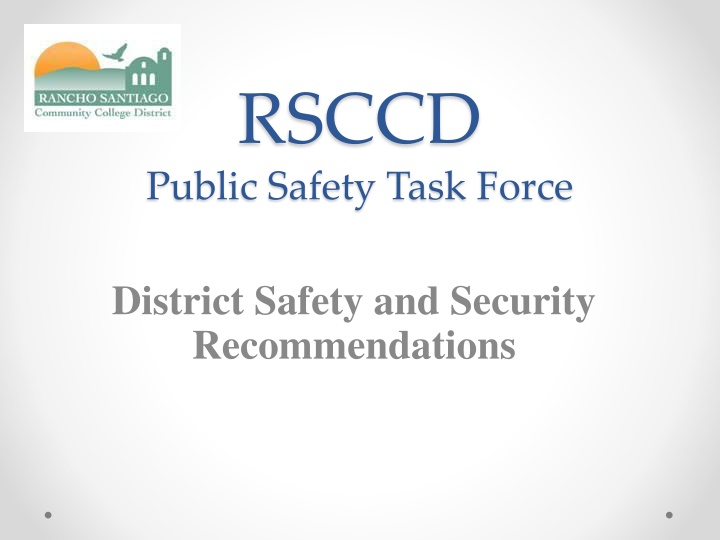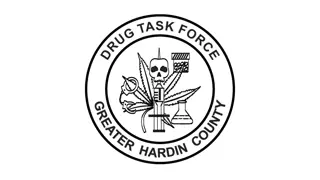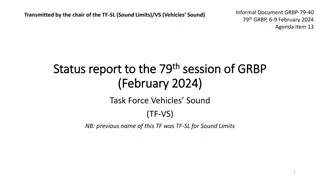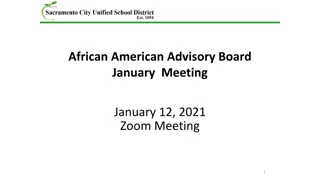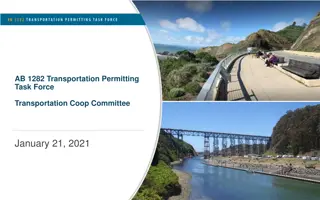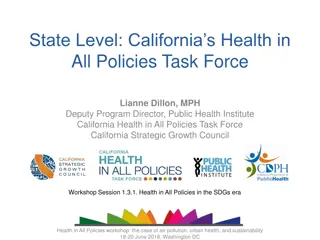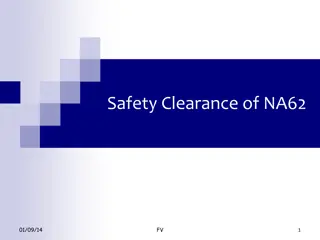RSCCD Public Safety Task Force Recommendations
The RSCCD Public Safety Task Force, established in September 2013, focuses on enhancing safety and security measures in response to potential threats like intruders or shooters on campus. The Task Force membership, timeline, and efforts to improve public safety practices are outlined. Challenges unique to college campuses, with their open and accessible nature, are also highlighted. Additionally, the collaboration with the U.S. Department of Justice's National Center for Campus Public Safety at the University of Vermont is referenced.
Download Presentation

Please find below an Image/Link to download the presentation.
The content on the website is provided AS IS for your information and personal use only. It may not be sold, licensed, or shared on other websites without obtaining consent from the author.If you encounter any issues during the download, it is possible that the publisher has removed the file from their server.
You are allowed to download the files provided on this website for personal or commercial use, subject to the condition that they are used lawfully. All files are the property of their respective owners.
The content on the website is provided AS IS for your information and personal use only. It may not be sold, licensed, or shared on other websites without obtaining consent from the author.
E N D
Presentation Transcript
RSCCD Public Safety Task Force District Safety and Security Recommendations
Public Safety Task Force September 2013 the Chancellor created a Public Safety Task Force (PSTF) The purpose of the Task Force is to make recommendations as to how the district and colleges can improve on current practices and increase the level of preparation for extreme threats to public safety, such as the intrusion of a shooter at one of our facilities .
Public Safety Task Force (PSTF) Membership Alistair Winter Interim Director Safety & Security (Chair PSTF). Paul Walters Consultant (Retired Chief of Santa Ana Police Department; Dr. Mike Collins - Vice President of Administrative Services SAC; Steve Kawa - Vice President of Administrative Services SCC; Sylvia LeTourneau - Assistant Vice Chancellor of Information Technology Service; Andy Gonis Faculty member from SAC; Beth Hoffman Faculty member from SCC; Mike Ediss and Ray Stowell CSEA representatives; Both Associated Student Governments were contacted for student representatives, but no one was appointed.
Public Safety Task Force (PSTF) Timeline o September 20th initial meeting with Paul Walters and Chancellor. o September 23rd first meeting with Paul Walters to discuss terms of reference and schedule. o November 4th first meeting of the PSTF. Discussion around timelines, terms of reference, and the proposed solutions. o November to January Research into possible solutions; meetings with Public Safety depts at Mt SAC and Biola University; telephone conversations with Public Safety Personnel at other various institutions. o February Two meetings with Paul Walters regarding final report and recommendations. o March 7th Presentation of recommendations to Chancellor. o March 17th Presentation of recommendations to PSTF. o March April Costing of recommendations and implementation planning.
U.S. Department of Justice National Center for Campus Public Safety University of Vermont is intended to foster collaboration among campus public safety directors The national center will be a one stop shop for campus public safety There will be training and technical assistance online and at the center
Challenges By their very nature, college campuses are designed to be open and accessible to all The safety of more than 40,000 students is entrusted to campus public safety
Research Texas State University School of Criminal Justice, Key Research Findings 2000-2010 by J. Peter Blair, PhD and M. Hunter Martindale. 84 Active Shooter Events (ASEs) occurred between 2000 and 2010. (Since 2010, there have been 40 additional ASEs) Active Shooter Events from 2000-2012 by J. Peter Blair, PH.D., M. Hunter Martaindale, M.S., and Terry Nichols, M.S. Between 2000 and 2008 - 1 ASE every other month, Between 2009 and 2012 increased to 1 per month (nearly 16 per year); The high rate continued in 2013 -- there were 15 incidents last year. The median response time for law enforcement was 3 minutes, and the median response time for solo officers was 2 minutes. The median number of people shot per event was 5, not including the shooter. Of the 51% of incidents that were still going when law enforcement arrived, 40% of the attackers either died by suicide or surrendered to police. In the other cases (60%), police officers used force to stop the attackers, most often with firearms.
Tactics In past events, such as the 1999 shootings at Columbine High School, police would remain outside a building until a trained SWAT (Special Weapons and Tactics) team arrived on the scene A single officer on the scene needs to intervene in an attack, knowing that body counts can rise in an active shooting event with every passing second
On the Clock Today the shooter knows that he s on the clock, he knows police are coming for him, they re going to stop him He has only a short window to do as much damage as he can
2013 Arapahoe High School shooting The suspect was heavily armed, with ammunition, a knife and three explosives Gunman, stopped firing on others and turned his weapon on himself. Pierson (shooter) killed himself less than 1 minute, 20 seconds after entering the school This was only possible because the armed police officers are assigned permanently to the campus on a full time basis
Time Time from the beginning of the shooting incident until resolution by a police officer This is one of the most important aspects To minimize the deadly impact an active shooter can have on the student and staff safety
RSCCD Safety Officers District safety officers are unarmed non-sworn personnel and do not possess peace officer status or police authority District safety officers may make private citizen s arrests pursuant to section 837 of the penal code
Recommendation 1: Structure of Safety & Security What was the best type of officer to meet the needs in the events of an extreme emergency? A full time regular police officer could cost anywhere from $140,000 - $170,000 per year, this is excluding police vehicles, equipment and supervision Private firm to provide armed guard security services and a contract for services for our campuses Hybrid department where officers who were selected and suitably qualified would be given specialized training and firearms. Recommendation: Transition from current unarmed public safety to a hybrid armed non sworn department.
Recommendation 2: Joint Training and Exercises Joint training plays a significant part in preparing for the possibility of an emergency situation on campus Local law enforcement agencies should be encouraged to use the vast resources of the campuses such as classrooms and space for drills. Recommendation: Establish close working relationships with local police departments in Santa Ana and Orange by training together whenever possible. Implementation - Active Shooter Training scheduled at SAC for August 15thwith Santa Ana Police. We have been reaching out to Orange Police Department to organize similar training.
Recommendation 3: Additional Officers and Supervisory Coverage The officers at SAC operate on a twenty four hour seven days a week basis, providing coverage to the whole District on the graveyard shift; SCC operates from 7 am to 11 pm providing coverage seven days a week for 16 hours a day; As SCC has expanded, with new buildings, many sporting events, and increases in the number of students there is need for twenty four hour seven days a week coverage at SCC and a dispatcher to assist officers during school hours. Currently, Lieutenants are the only managerial posts on campuses. They are on call 24/7. Administrative support for the Lieutenants is necessary and also additional supervisory coverage for officers is required. Recommendation: Recruit additional officers to provide graveyard coverage at SCC; Recruit a Dispatcher for SCC; Create supervisory positions to support Lieutenants in their roles and recruit accordingly.
Recommendation 4: Environmental Safety and Emergency Services position One of the key aspects in preparing for an extreme emergency is training and drills The Environmental Safety and Emergency Services position was responsible for preparing Emergency Plans, facilitating training and drills for the District. Recommendation: Recruit a part-time Environmental Safety and Emergency Services position.
Recommendation 5: Community Policing Safety and Security need to be accessible and visible, making sure they interact with the campus community in a pro active way not just reactive Use a community policing style which aims at working closely with the staff and students seeking to address their concerns and problems. Recommendation: Formalize training in Community Policing for Safety and Security Department. Full time officers were trained in Community Policing methods at recent training day. Part time officer training scheduled for August. This training will be the first of more regular training for the officers.
Recommendation 6: Written Policies and Formal Agreements Coordination must occur through regular meetings, joint trainings, and exercises Participating in these activities prepares personnel for critical incidents and builds lasting relationships Strong relationships lead to better communication and effective response to critical incidents Recommendation: Memorandum of Understanding (MOU) and Mutual Aid to be developed with both local police agencies (SAPD and OPD) for planning, training and responding to a need for local law enforcement services on RSCCD property. Discussions have been held with Santa Ana Police regarding formalizing and improving our understanding, in regard to training and cooperation. Future discussions planned with Orange Police.
Recommendation 7: Interoperability During a critical incident such as a school shooting direct communications between police agencies and the college staff becomes extremely vital to the overall success of the response Interoperability is defined as public safety agencies being able to talk across disciplines and jurisdictions via radio communications systems, exchanging voice and data with one another on demand, in real-time. Recommendation: The Director of RSCCD Security should work with local Police Chiefs to gain access to their existing 800 MHz radios systems in the event of a shooting on campus or an emergency. To be discussed with Santa Ana and Orange Police Department at our next meeting.
Recommendation 8: Media and Public Relations Unprepared colleges can be easily overwhelmed by intense media attention It is important that local and campus law enforcement work together and utilize the skills of PIOs Recommendation: Establish a close working relationship with the PIO s of both SAPD and OPD. Develop a marketing plan for the administrators, faculty and students to be aware of what to do in case of an emergency such as an Active Shooter. This issue is to be further discussed with both local police departments.
Recommendation 9: Mass Communication Currently four separate systems: AlertU, BerBee, in house designed email system and public address system Technology has advanced significantly in the area of mass communication and there are numerous single sign on platforms which with one click can send messages to cell phones, email, social media, leave voice mails, and also update all our web sites Recommendation: Purchase a single sign on mass communication platform to use in the event of an extreme emergency. Also make it an opt out system so that all the campus community is automatically signed up when registration takes place. Emergency communication software purchased and implementation has commenced; we are working with ITS to enable this. The software should be in place and operating for Fall semester 2014.
Recommendation 10: Coordination Plans Protecting colleges and universities is different than traditional businesses or residences, because there is a public safety department located on campus Coordination, training, and established working policies are more important than ever Local law enforcement and campus public safety should coordinate in developing, reviewing, and implementing emergency response and business continuity plans. Recommended: RSCCD campus Safety & Security and local police from Santa Ana and Orange must coordinate with each other in order to be prepared to respond to critical incidents such as an Active Shooter. First draft for an active shooter plan has been written. Active Shooter training scheduled at SAC for August 15thto test responsiveness of Safety & Security officers. Meeting arranged with Orange Police to organize something similar for SCC.
Recommendation 11: Orange County Police Chiefs and Sheriff s Association Forum to establish relations, be kept abreast of the issues in Orange County facing law enforcement Become involved in training opportunities and various task forces and committees that address crime, terrorism risks and latest public safety trends in Orange County. Recommendation: The Director of Security for RSCCD become an associate member of the OC Chiefs and Sheriffs Association. Chief Walters is contacting the association in regard to membership for the Director Safety & Security position. Awaiting invitation from the Association.
Implementation Timeline Year One Implementation plans and estimated costs: One time - Conversion costs per position (includes training and equipment) Ongoing costs - Annual training cost per position One time conversion costs Total Ongoing Costs total per year Year one Total # of Positions Supervisory positions to be trained and converted to hybrid, armed non-sworn. Director, 2 Lieutenants working day shift at SAC and SCC, 3 Sergeants working swing shift at SAC, SCC and CEC. 6 $2,950 $17,700 $2,000 12000 Step one - $29,700 Select and train officer (from current pool of officers). 4 officers day shift; 2 at SAC and 2 at SCC; 4 Officers swing shift; 2 at SAC and 2 at SCC, 1 officer day shift at CEC and 1 officer day shift at OEC. Totals 10 $2,950 $29,500 $2,000 20000 Step two - $49,500 $47,200 $32,000 $79,200 These costs do not include any salary increases for the officers who are now carrying firearms. Eventually through natural attrition the plan is to recruit suitably trained officers, so that all officers eventually are armed. Footnote:
Cost Estimate for Salary and Benefits of PSTF Recommendations (#1,3,4) Cost Estimate for Salary and Benefits of District Safety Recommendations Recommendation #1: Six new armed non-sworn officers at an estimated range 13 Mid Range High Range Three officers on day shift Three officers on swing shift $273,513- $304,677 $283,326- $316,047 Recommendation #3: One new safety officer for SCC graveyard shift range 9 $83,986- $93,190 Two new16 hour/week officers for SCC weekend graveyard coverage (a) $33,758- $33,758 One new dispatcher at SCC $77,713- $85,956 Three new managers (Sergeant). 1 each at SAC, SCC & CEC. $215,069- $286,703 Recommendation #4: 19 hour/week Env. Safety & Em. Services $43,304- $50,132 Total Estimated Salary and Benefit Cost per year. $1, 010, 669- $1,086,663
